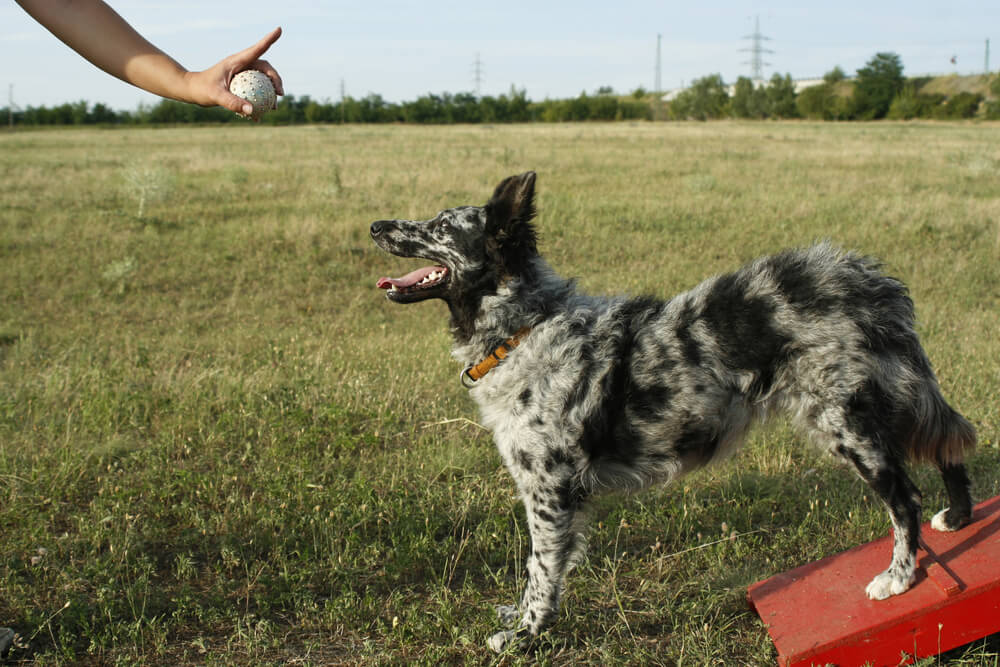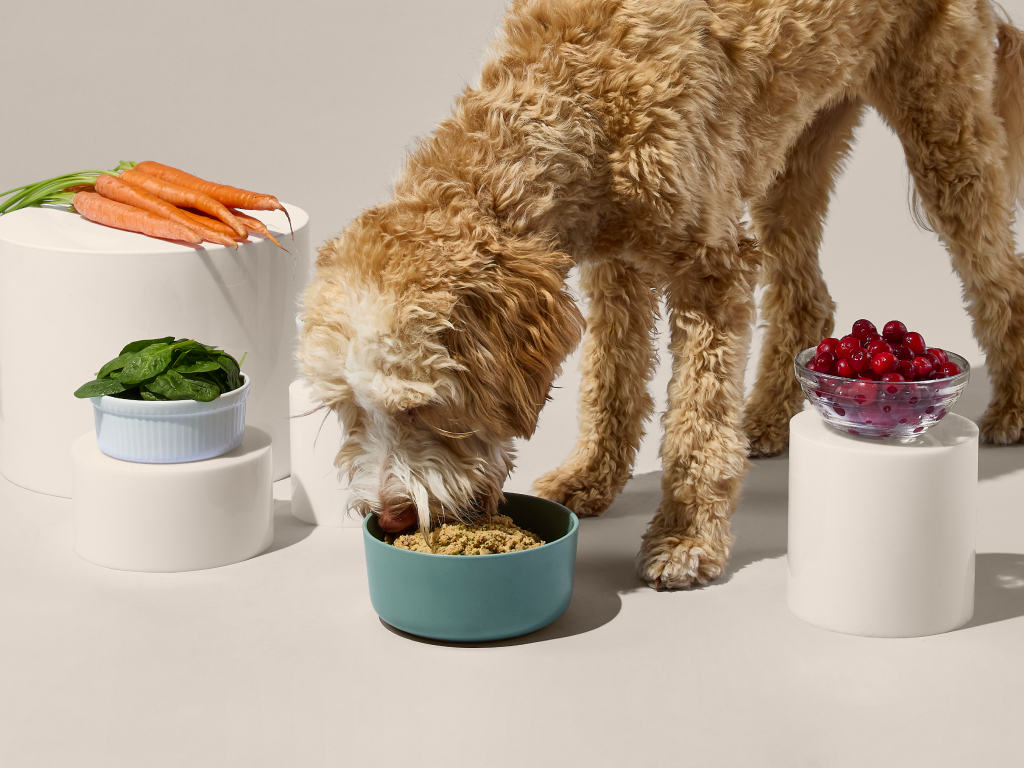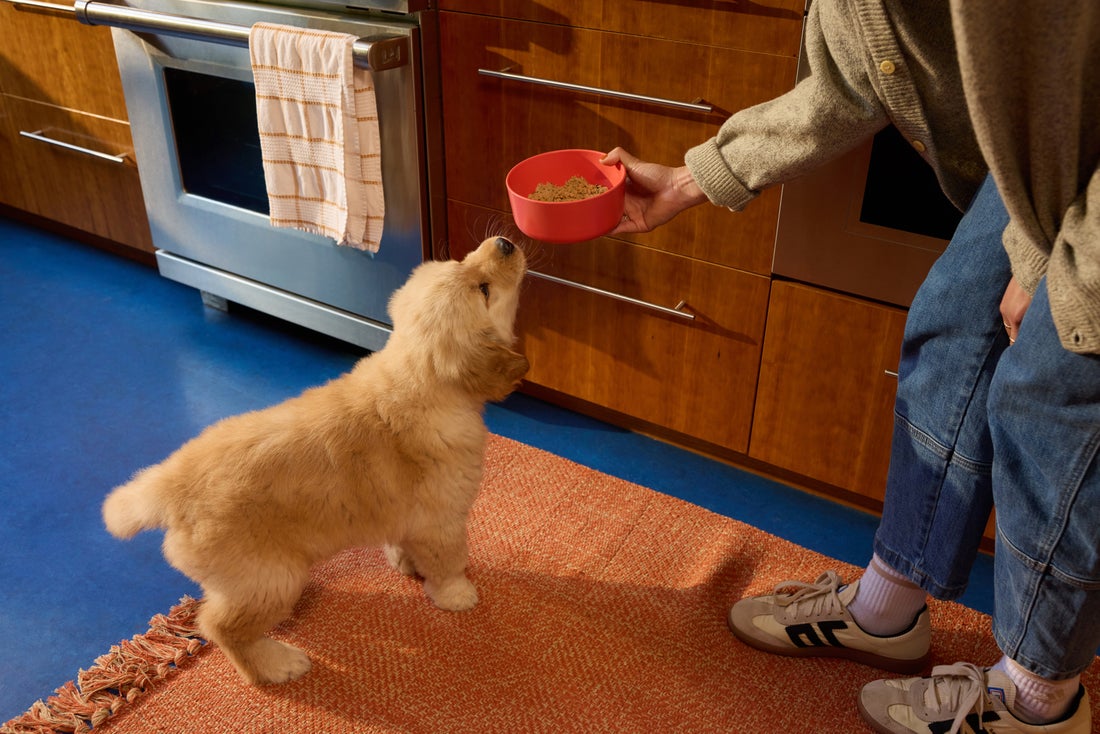Hey Ollie blog readers! We’re offering you an exclusive 60% OFF your starter box! Try now!
Dog training is more than good manners—it’s necessary for your pup’s lifelong health and happiness. But knowing how to train your dog can be overwhelming, especially if you’re training your first puppy. Set yourself and your four-legged friend up for success—and fun—with our ultimate dog training guide.
Potty Training
Potty training or house training is an essential skill for the modern dog. The first thing you’ll need when house training a puppy is unlimited patience, consistency, and kindness. Support your puppy’s learning by using a process that makes being right easy. This includes:
- Creating a routine — Take your puppy outside after activity, rest, and meals. Feeding your puppy at the same time every day will help promote more predictable poops.
- Training your puppy to sleep in a crate — Puppies instinctively prefer not to potty in their crate, because the crate feels like a den. Thus the crate is a great tool for helping your puppy learn to “hold it” between outings.
- Knowing your puppy’s physical limits — Puppies can control their bladder only one hour for every month of their age, and don’t gain full control until they are 4 to 6 months old.
- Managing accidents — Clean up accidents thoroughly with an enzymatic cleaner to remove odors.
- Supervising your puppy — Keep an eye on your puppy at all times to minimize the risk of accidents and keep them safe.
- Learning your puppy’s signals and habits — Some puppies whine, circle, or sniff before they “go,” while others may have bowel movements at specific times of the day.
Crate Training
A crate is a safe and comfortable space for your dog and can accelerate house training. Dogs who create positive associations with their crates also feel calm and secure during travel, boarding, grooming, and emergencies, making this an essential life skill for all dogs.
When crate training a dog, use only positive training methods and never use the crate as punishment. Introduce the crate gradually, using long-lasting treats such as a food-filled toy to make the experience happy.
Basic Training
Starting an Obedience Program
Basic obedience training helps your dog learn good behavior and sets the stage for future learning. To ensure your dog succeeds, you must be committed and consistent. While different methods and theories on how to train a dog abound, positive reinforcement is the only method that veterinary behavior experts support.
To keep training enjoyable for your dog, keep sessions short, use playtime and tasty treats as rewards, and break down complex behaviors into smaller, easier steps.
Essential Cues
Common obedience behaviors for dogs create clear expectations, such as when to move, where to go, and how to interact with the world.
How to Teach a Dog to Sit
Teaching a dog to sit is usually the first cue pet parents choose because it’s an easy training task. As your dog masters this simple task, they gain confidence that helps motivate them to learn other desired behaviors. To teach your dog to sit, follow these steps:
- With your dog in a standing position, hold a treat in front of them to gain their attention.
- Move the treat up to a position slightly above your dog’s head while using your other hand to gently push their back end to the ground.
- Say “Sit” as your dog moves into the sit position.
- Reward your dog with a treat and praise.
- Once your dog gets the hang of sitting on their own, you’ll no longer need to use your hand to push their back end down.
How to Teach a Dog to Come When Called
Teaching your dog to come when called is a valuable skill for many different situations. It allows them more freedom since you can allow them to play off-leash in safe environments, knowing they will return when asked. Good recall skills also help keep your dog safe since you can prevent them from running into dangerous situations. To teach your dog to come when called, follow these steps:
- Choose a word you will consistently use when calling your dog, such as “Come” or “Here.”
- Choose high-value treats that will motivate your dog to respond, such as pieces of plain chicken breast or cheese.
- Begin in a quiet, distraction-free area to help your dog focus on you.
- Standing a few feet away from your dog, say their name to get their attention, and then say the cue word in a happy, upbeat voice.
- Praise your dog as soon as they come toward you, and give them the treat when they reach you.
- Once your dog responds to the cue reliably, move farther away to increase the distance between you and your dog.
- Once your dog masters the skill in a quiet area, introduce distractions, such as other people or pets, and practice the skill in different settings, such as a dog park. You can use a long training leash when you first move the skill to a new area to ensure your dog’s safety.
How to Teach a Dog to Stay
Teaching your dog to stay means they will remain in a specific spot until you release them. This skill is helpful during mealtimes, when you want your dog to stay away from the table to prevent begging. To teach your dog to stay, follow these steps:
- Choose a cue you will use to tell your dog to stay, such as “Stay,” as well as the cue you will use to release your dog, such as “OK.”
- Standing in front of your dog, say “Stay” while raising your hand in a “Stop” position to reinforce the verbal cue.
- When your dog stays in place for two to three seconds, say the release word and reward them with praise and a treat.
- Slowly work up to asking your dog to stay for longer periods of time. Star with a few seconds and gradually increase to time to a minute or longer.
- Ensure you set your dog up for success. If you notice their body language suggesting they are about to break their stay, release them and reward them for their efforts.
- Once your dog reliably stays in one spot for several seconds, you can start to increase the distance by taking a step or two back, and then returning to release and reward them. Always say the release word before rewarding your dog for successfully performing the behavior.
- Once your dog masters the skill in a quiet area, introduce distractions, such as other people or pets, and practice the skill in different environments.
How to Teach a Dog to Ignore an Item in Their Environment
Teaching your dog to “Leave it” is important to avoid potential harm, such as trash on the ground, wildlife, or unfamiliar dogs. To teach your dog to ignore harmful items, follow these steps:
- Choose a phrase you will use for this specific cue, such as “Leave it.”
- Choose high-value treats, such as pieces of plain chicken breast or cheese, that will motivate your dog to respond. You’ll also need some lower-value treats, such as pieces of dog food.
- Put a lower-value treat in one hand, close your hand around it, and show your dog.
- When your dog sniffs or paws at your hand to try to get the treat, keep your hand closed and wait patiently.
- As soon as your dog stops trying to get the treat, give them the higher-value treat from your other hand.
- Add the “Leave it” cue by repeating the same exercise, but firmly say “Leave it” when your dog tries to get the treat. When your dog backs off or ignores the treat in your hand, reward them with the higher-value treat and praise.
- Once your dog consistently backs off from the treat in your closed hand on the “Leave it” cue, open your hand slightly so they can see the treat. If they go for the treat, close your hand and repeat the cue. Repeat this exercise until your dog successfully ignores the treat. Gradually open your hand more until your dog can ignore the treat in your open palm.
- Next, place the treat on the floor and cover it with your hand. Give the “Leave it” cue, and when your dog backs away or ignores the treat, praise them and give them a high-value treat. Work up to being able to leave the treat uncovered. If your dog goes for the treat, cover it and try again.
- Once your dog consistently leaves alone treats when asked, try the exercise with other tempting objects, such as toys. Drop these items on the ground near your dog and give the “Leave it” cue. Reward them when they succcessfully ignore the object.
Training Tools
The right tools will help you communicate with your dog and keep them safe during training. Recommended tools include:
- Clicker — The clicker is a small handheld tool that makes a unique sound when pressed, marking the exact moment your dog does something right. When your dog receives a treat immediately after the click, they learn to connect the action with the reward, and will more likely repeat the good behavior. While you can use “Yes” or another sound to mark the behavior, the clicker’s consistent and precise sound makes it the best choice for beginners.
- Leash and collar or harness — Keeping your dog on a leash during training keeps them safe and improves control and focus. Harnesses are a suitable alternative to collars for dogs who pull or have certain health conditions. Ensure your dog’s harness or collar fits well to prevent slipping or accidental escape.
- Tasty treats or your dog’s favorite toy — Positive reinforcement training involves rewarding good behavior, so have plenty of high-value treats or toys ready. Behaviors that are rewarded get repeated!
Leash Training Dogs and Puppies
The leash is more than a tether connecting you to your pup. A leash provides safety and control in new or busy environments while your dog learns to focus and respond to your cues. A leash that is used gently and is attached to a non-restrictive harness helps you communicate with your dog and strengthens your special bond.
Here’s some leash training tips to get you started:
- Start leash training your puppy or dog in a calm, quiet place that has few distractions. Begin with some focus games or simple commands to get your dog’s attention.
- Reward your dog with a click and treat whenever there’s slack in the leash.
- Once your dog can walk nicely on a loose leash at home, start practicing in different places.
- If your dog pulls or lunges on the leash, try “being a tree”—stand still and wait until your dog looks back or the leash goes slack.
- Another option is to walk in the opposite direction so your dog’s attention goes back to you. Leash pulling is a self-rewarding behavior and a tough habit to break, so be patient while your dog learns to walk politely.
Behavioral Training
Despite our best efforts to teach our dogs to do what we want and to prevent unwanted behaviors, problematic behaviors are common. Addressing these issues promptly and with professional assistance can help avoid harm to the dog-owner bond. Common problems include:
- Barking — Dogs bark as a means of communication. If excessive barking causes problems at home, understanding why your pup is barking can help you figure out how to stop your dog from barking.
- Chewing — Puppies may chew to relieve teething-related discomfort, while adult dogs may chew to relieve boredom, anxiety, or stress. Address your dog’s chewing by identifying the cause and providing a safe outlet, such as teething toys, more mental enrichment, or anti-anxiety medication.
- Jumping — Dogs jump to seek attention. Manage your dog’s jumping by teaching them an incompatible behavior, such as lying down or going to their bed or rug.
- Aggression — Aggression is a behavior emergency. Talk to your veterinarian if your dog or puppy is acting aggressively toward people or other pets. However, consider aggressive dog training or behavior modification only after ensuring your dog’s behavior is not related to health issues.
Dog Socialization Training
Proper socialization is an important component of dog training that helps them become confident and well-adjusted companions. Socializing your dog isn’t only about meeting new people and pups, it also involves getting your dog used to new sights, sounds, and activities, including grooming and veterinary visits. When your dog learns to stay calm despite different environments, they’re less likely to show fearful behaviors, such as barking, biting, or shyness.
Effective socialization sessions involve helping your dog be successful and safe. This means staying in your dog’s comfort zone and avoiding potentially scary or unmanageable situations. Before you show your pup the big wide world, keep everyone safe by learning how to introduce dogs and people.
Advanced Training
After learning how to train a dog, many pet parents realize the process is rewarding and don’t want it to end. Fortunately, advanced training can take your skills—and your bond—to the next level. Go beyond basic cues and behaviors with options such as:
- Proofing — Training is an ongoing process. Keep your dog’s skills sharp with proofing, which involves testing their training in new and different environments, such as the park, pet store, or a dog-friendly patio. Raise the challenge level slowly, so your dog doesn’t get frustrated or overwhelmed trying to perform in their new surroundings.
- Trick training — Tricks are more than silly behaviors—they’re a great way to stretch your skills as a trainer and improve your communication with your dog. Plus, they’re fun! Popular tricks to teach your dog include “Shake,” “Rollover,” and “Bow.”
- Dog sports — Structured activities and sports, such as agility, competition obedience, canine fitness, rally obedience, dock diving, scent work, tracking, disc dog, and barn hunt, are great ways to bond with your dog and take your training to a whole new level. Whether you choose to compete or simply have fun, dog sports build your dog’s confidence, keep them fit and active, and provide mental stimulation—and you become an incredible team. Get started by finding a class near you or signing up for an online course.
- Therapy work — Therapy work is immensely rewarding for dogs, handlers, and those they interact with in hospitals, schools, nursing homes, and assisted living facilities. If your dog is calm and affectionate with people, consider pursuing additional training to become a therapy dog team.
- Enrichment activities — Enrichment activities challenge your dog’s mind in new and fun ways. They also complement your training by rewarding and refining your pup’s critical thinking skills. Mentally enrich your dog with puzzle feeders, foraging toys such as snuffle or activity mats, and interactive toys.
FAQs
How long does training take?
Training sessions should be short, especially when you’re learning how to train a dog or training a puppy. Hold several short sessions—five minutes or less—a few times per day. Regular training sessions will speed up your dog’s progress and help you reach your goals sooner, so aim for several training times each week. Finally, training timelines vary per dog, based on the dog’s age, learning history, training schedule, and the owner’s training goals. Prioritize steady progress rather than achieving your goal in a set time frame. Ultimately, training is never finished or complete—like a muscle, it requires regular exercise to keep it strong!
What’s the most effective method for training a dog?
Science shows that positive reinforcement is not only effective but also helps build a strong, trusting bond between you and your dog. According to the American Veterinary Society of Animal Behavior (AVSAB) Position Statement on Humane Dog Training, “reward-based learning offers the most advantages and least harm to the learner’s welfare. Research supports the efficacy of reward-based training to address unwanted and challenging behaviors. There is no evidence that [punishment or correction-based] training is necessary for dog training or behavior modification.”
If you need more evidence, positive reinforcement-based training is the standard method for managing and caring for wild animals in zoos and sanctuaries worldwide. Positive reinforcement can teach a tiger to accept a blood draw and can definitely help you teach your dog to come when called!
What if my dog doesn’t respond to training?
Occasional setbacks are normal during training, but if your dog often struggles to learn new skills or continues to misbehave, the issue may lie with your training techniques, such as timing or a lack of consistency. Although you can easily become frustrated, remember that your dog is trying their best. Consider hiring a professional dog trainer to review your training approach, goals, and plan. They can help you improve and find success.
Can older dogs be trained?
Old dogs can definitely learn new tricks! Training is a great way to bond with your senior dog, keep their mind and body active, and potentially help prevent or minimize age-related issues. Ensure you consider your older dog’s comfort and health, keep training sessions short, and adjust your goals based on how much your dog can handle. For instance, if your dog has arthritis, avoid exercises like jumping or repetitive sitting. If your dog’s hearing or vision is declining, use hand signals or verbal cues, respectively, to communicate.
Tagged As:

The nutrition your dog needs,
the food they want.

Enjoying our articles? Subscribe our Newsletters and get new articles directly to your inbox
You might also like
29 September 2025
6 MINS READ
How Is Fresh Dog Food Made?
Unlike standard kibble that undergoes high-heat processing, fresh dog food maintains the natural integrity of ingredients while avoiding artificial additives and fillers. But what exactly goes int…
by Ollie Pets
29 September 2025
7 MINS READ
Is Lamb a Good Protein for Sensitive Stomachs?
Lamb provides significant nutritional benefits for dogs, particularly for pups with sensitive stomachs who need a specialized diet. This protein-rich meat offers an excellent alternative for pups …
by Ollie Pets
29 September 2025
7 MINS READ
Top 10 Fresh Ingredients for Your New Puppy’s Bowl
As dog parents, we naturally want to provide our pups with a strong start in life. This means giving them nutrition that is able to support their rapid growth, abundant energy, and developing immu…
by Ollie Pets







